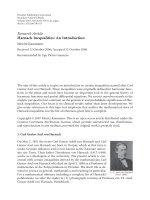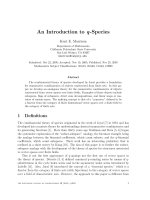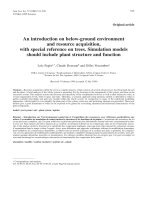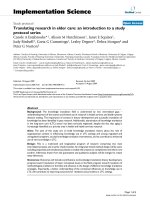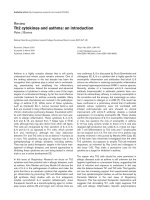CHIROPRACTIC: AN INTRODUCTION
Bạn đang xem bản rút gọn của tài liệu. Xem và tải ngay bản đầy đủ của tài liệu tại đây (182.37 KB, 6 trang )
<span class="text_page_counter">Trang 1</span><div class="page_container" data-page="1">
Chiropractic: An Introduction
<small>© Matthew Lester </small>
Chiropractic is a health care profession that focuses on the
relationship between the body’s structure—mainly the spine—and its functioning. Although practitioners may use a variety of
treatment approaches, they primarily perform adjustments
(manipulations) to the spine or other parts of the body with the goal of correcting alignment problems, alleviating pain, improving function, and supporting the body’s natural ability to heal itself.
Key Points
• Most research on chiropractic has focused on spinal
manipulation. Spinal manipulation appears to benefit some people with low-back pain and may also be helpful for headaches, neck pain, upper- and lower-extremity joint conditions, and whiplash-associated disorders.
• Side effects from spinal manipulation can include temporary headaches, tiredness, or discomfort in the parts of the body that were treated. There have been rare reports of serious
complications such as stroke, but whether spinal manipulation actually causes these complications is unclear. Safety remains an important focus of ongoing research.
• Tell all your health care providers about any complementary health practices you use. Give them a full picture of what you do to manage your health. This will help ensure coordinated and safe care.
Overview and History
<i>The term “chiropractic” combines the Greek words cheir (hand) and </i>
<i>praxis (practice) to describe a treatment done by hand. Hands-on </i>
therapy—especially adjustment of the spine—is central to chiropractic care. Chiropractic is based on the notion that the relationship between the body’s structure (primarily that of the spine) and its function (as coordinated by the nervous system) affects health.
Spinal adjustment/manipulation is a core treatment in chiropractic care, but it is not synonymous with chiropractic. Chiropractors commonly use other treatments in addition to spinal manipulation,
</div><span class="text_page_counter">Trang 2</span><div class="page_container" data-page="2"><small>2 </small>
and other health care providers (e.g., physical therapists or some osteopathic physicians) may use spinal manipulation.
Use in the United States
In the United States, chiropractic is often considered a complementary health practice.
According to the 2007 National Health Interview Survey (NHIS), which included a comprehensive survey of the use of complementary health practices by Americans, about 8 percent of adults (more than 18 million) and nearly 3 percent of children (more than 2 million) had received chiropractic or osteopathic manipulation in the past 12 months. Additionally, an analysis of NHIS cost data found that adults in the United States spent approximately $11.9 billion out-of-pocket on visits to complementary health practitioners—$3.9 billion of which was spent on visits to practitioners for chiropractic or osteopathic manipulation.
Many people who seek chiropractic care have low-back pain. People also commonly seek chiropractic care for other kinds of musculoskeletal pain (e.g., neck, shoulder), headaches, and extremity (e.g., hand or foot) problems.
An analysis of the use of complementary health practices for back pain, based on data from the 2002 NHIS, found that chiropractic was by far the most commonly used therapy. Among survey respondents who had used any of these therapies for their back pain, 74 percent (approximately 4 million Americans) had used chiropractic. Among those who had used chiropractic for back pain, 66 percent perceived “great benefit” from their treatments.
Treatment
During the initial visit, chiropractors typically take a health history and perform a physical examination, with a special emphasis on the spine. Other examinations or tests such as x-rays may also be performed. If chiropractic treatment is considered appropriate, a treatment plan will be developed.
During followup visits, practitioners may perform one or more of the many different types of adjustments and other manual therapies used in chiropractic care. Given mainly to the spine, a chiropractic adjustment involves using the hands or a device to apply a controlled, rapid force to a joint. The goal is to increase the range and quality of motion in the area being treated and to aid in restoring health. Joint mobilization is another type of manual therapy that may be used.
Chiropractors may combine the use of spinal adjustments and other manual therapies with several other treatments and approaches such as:
• Heat and ice
• Electrical stimulation • Relaxation techniques
• Rehabilitative and general exercise
• Counseling about diet, weight loss, and other lifestyle factors • Dietary supplements.
</div><span class="text_page_counter">Trang 3</span><div class="page_container" data-page="3">What the Science Says
Researchers have studied spinal manipulation for a number of conditions ranging from back, neck, and shoulder pain to asthma, carpal tunnel syndrome, fibromyalgia, and headaches. Much of the research has focused on low-back pain, and has shown that spinal manipulation
<i>appears to benefit some people with this condition. (For more information, see the Spinal </i>
<i>Manipulation for Low-Back Pain fact sheet at nccam.nih.gov/health/pain/spinemanipulation.htm). </i>
A 2010 review of scientific evidence on manual therapies for a range of conditions concluded that spinal manipulation/mobilization may be helpful for several conditions in addition to back pain, including migraine and cervicogenic (neck-related) headaches, neck pain, upper- and lower-
extremity joint conditions, and whiplash-associated disorders. The review also identified a number of conditions for which spinal manipulation/mobilization appears not to be helpful (including asthma, hypertension, and menstrual pain) or the evidence is inconclusive (e.g., fibromyalgia, mid-back pain, premenstrual syndrome, sciatica, and temporomandibular joint disorders).
Safety
• Side effects from spinal manipulation can include temporary headaches, tiredness, or discomfort in the parts of the body that were treated.
• There have been rare reports of serious complications such as stroke, cauda equina
syndrome (a condition involving pinched nerves in the lower part of the spinal canal), and worsening of herniated discs, although cause and effect are unclear.
• Safety remains an important focus of ongoing research:
o A 2007 study of treatment outcomes for 19,722 chiropractic patients in the United Kingdom concluded that minor side effects (such as temporary soreness) after cervical spine manipulation were relatively common, but that the risk of a serious adverse event was “low to very low” immediately or up to 7 days after treatment.
o A 2009 study that drew on 9 years of hospitalization records for the population of Ontario, Canada analyzed 818 cases of vertebrobasilar artery (VBA) stroke (involving the arteries that supply blood to the back of the brain). The study found an association between visits to a health care practitioner and subsequent VBA stroke, but there was no evidence that visiting a chiropractor put people at greater risk than visiting a
primary care physician. The researchers attributed the association between health care visits and VBA stroke to the likelihood that people with VBA dissection (torn arteries) seek care for related headache and neck pain before their stroke.
Practitioners: Education and Licensure
Chiropractic colleges accredited by the Council on Chiropractic Education (CCE) offer Doctor of Chiropractic (D.C.) degree programs. (CCE is the agency certified by the U.S. Department of
Education to accredit chiropractic colleges in the United States.) Admission to a chiropractic college requires a minimum of 90 semester hour credits of undergraduate study, mostly in the sciences. Chiropractic training is a 4-year academic program that includes both classroom work and direct experience caring for patients. Coursework typically includes instruction in the biomedical sciences, as well as in public health and research methods. Some chiropractors
</div><span class="text_page_counter">Trang 4</span><div class="page_container" data-page="4"><small>4 </small>
Chiropractic is regulated individually by each state and the District of Columbia. All states require completion of a Doctor of Chiropractic degree program from a CCE-accredited college. Examinations administered by the National Board of Chiropractic Examiners are required for licensing and include a mock patient encounter. Most states require chiropractors to earn annual continuing education credits to maintain their licenses. Chiropractors’ scope of practice varies by state in areas such as the dispensing or selling of dietary supplements and the use of other complementary health practices such as acupuncture or homeopathy.
If You Are Thinking About Seeking Chiropractic Care
• Ask about the chiropractor’s education and licensure.
• Mention any medical conditions you have, and ask whether the chiropractor has specialized training or experience in the condition for which you are seeking care.
• Ask about typical out-of-pocket costs and insurance coverage. (Chiropractic is covered by many health maintenance organizations and private health plans, Medicare, and state workers’ compensation systems.)
• Tell the chiropractor about any medications (prescription or over-the-counter) and dietary supplements you take. If the chiropractor suggests a dietary supplement, ask about
potential interactions with your medications or other supplements.
• Tell all of your health care providers about any complementary health practices you use. Give them a full picture of what you do to manage your health. This will help ensure coordinated and safe care. For tips about talking with your health care providers about complementary and alternative medicine, see NCCAM’s Time to Talk campaign at nccam.nih.gov/timetotalk/.
NCCAM-Funded Research
NCCAM-supported research on chiropractic care includes projects that have focused on: • Spinal manipulation for back pain, neck pain, and headache, as well as for other health
conditions such as temporomandibular disorders
• Development of a curriculum to increase the understanding of evidence-informed practice in chiropractic educational institutions
• Influence of patients’ satisfaction with care on their response to treatment, in a study that compared chiropractic and medical care in a group of back-pain patients.
NCCAM also funded establishment of a developmental center for research in chiropractic at the Palmer Center for Chiropractic Research. Investigators at Palmer and at other partnering institutions conduct basic and clinical research on chiropractic treatment approaches, how they might work, and diseases and conditions for which they may be most helpful.
</div><span class="text_page_counter">Trang 5</span><div class="page_container" data-page="5">References
<i><small>Agency for Health Care Policy and Research. Chiropractic in the United States: Training, Practice, and Research. Rockville, </small></i>
<small>MD: Agency for Health Care Policy and Research; 1997. AHCPR publication no. 98-N002. </small>
<small>Barnes PM, Bloom B, Nahin RL. Complementary and alternative medicine use among adults and children: United </small>
<i><small>States, 2007. CDC National Health Statistics Report #12. 2008. </small></i>
<i><small>Bronfort G, Haas M, Evans R, et al. Effectiveness of manual therapies: the UK evidence report. Chiropractic & Osteopathy. </small></i>
<small>2010;18(3):1-33. </small>
<small>Cassidy JD, Boyle E, Côté P, et al. Risk of vertebrobasilar stroke and chiropractic care: results of a population-based </small>
<i><small>case-control and case-crossover study. Journal of Manipulative and Physiological Therapeutics. 2009;32(2 S208. (Republished from Spine. 2008;33(4 Suppl):S176-S183.) </small></i>
<small>Suppl):S201-Coulter ID, Hurwitz EL, Adams AH, et al. Patients using chiropractors in North America: who are they, and why are </small>
<i><small>they in chiropractic care? Spine. 2002;27(3):291-296. </small></i>
<i><small>The Council on Chiropractic Education. Standards for Doctor of Chiropractic Programs and Requirements for Institutional </small></i>
<i><small>Status January, 2007. The Council on Chiropractic Education Web site. Accessed at </small></i>
<small> on November 23, 2009. </small>
<i><small>Dagenais S, Haldeman S. Chiropractic. Primary Care. 2002;29(2):419-437. </small></i>
<i><small>Eisenberg DM, Cohen MH, Hrbek A, et al. Credentialing complementary and alternative medical providers. Annals of </small></i>
<i><small>Internal Medicine. 2002;137(12):965-973. </small></i>
<i><small>Ernst E. Chiropractic: a critical evaluation. Journal of Pain and Symptom Management. 2008;35(5):544-562. </small></i>
<i><small>Gouveia LO, Castanho P, Ferreira JJ. Safety of chiropractic interventions: a systematic review. Spine. 2009; 34(11):E405-E413. </small></i>
<small>Kanodia AK, Legedza AT, Davis RB, et al. Perceived benefit of complementary and alternative medicine (CAM) for back </small>
<i><small>pain: a national survey. Journal of the American Board of Family Medicine. 2010;23(3):354-362. </small></i>
<i><small>Kaptchuk TJ, Eisenberg DM. Chiropractic: origins, controversies, and contributions. Archives of Internal Medicine. </small></i>
<small>1998;158(20):2215-2224. </small>
<i><small>Meeker WC, Haldeman S. Chiropractic: a profession at the crossroads of mainstream and alternative medicine. Annals </small></i>
<i><small>of Internal Medicine. 2002;136(3):216-227. </small></i>
<small>Nahin RL, Barnes PM, Stussman BJ, et al. Costs of complementary and alternative medicine (CAM) and frequency of </small>
<i><small>visits to CAM practitioners: United States, 2007. CDC National Health Statistics Report #18. 2009. </small></i>
<small>Theil HW, Bolton JE, Docherty S, et al. Safety of chiropractic manipulation of the cervical spine: a prospective national </small>
Toll-free in the U.S.: 1-888-644-6226
TTY (for deaf and hard-of-hearing callers): 1-866-464-3615 Web site: nccam.nih.gov
E-mail:
</div><span class="text_page_counter">Trang 6</span><div class="page_container" data-page="6">Web site: www.clinicaltrials.gov
Research Portfolio Online Reporting Tools Expenditures & Results (RePORTER)
RePORTER is a database of information on federally funded scientific and medical research projects being conducted at research institutions.
Web site: projectreporter.nih.gov/reporter.cfm
Acknowledgments
NCCAM thanks the following individuals for their technical expertise and review of this publication: Gert Bronfort, D.C., Ph.D., Northwestern Health Sciences University; Joel Pickar, D.C., Ph.D., Palmer Center for Chiropractic Research; William Meeker, D.C., M.P.H., Palmer College-West; and Partap Khalsa, D.C., Ph.D., NCCAM.
<i>This publication is not copyrighted and is in the public domain. Duplication is encouraged. </i>
NCCAM has provided this material for your information. It is not intended to substitute for the medical expertise and advice of your primary health care provider. We encourage you to discuss any decisions about treatment or care with your health care provider. The mention of any product, service, or therapy is not an endorsement by NCCAM.
National Institutes of Health ♦♦♦
U.S. Department of Health and Human Services
<small>D403 </small>
<small>Created November 2007 Updated May 2012 </small>
</div>
